In construction, plans change all the time. A shipment runs late, a subcontractor misses a day, or a small error in a drawing grows into an expensive problem.
Deadlines move, budgets climb, and project teams spend hours chasing updates through emails and paperwork.
With so much unpredictability, it’s easy to see why many owners question the value of construction project management software. It looks like another expense in an industry where costs are already high.
But the right software turns that uncertainty into measurable results. It helps projects close faster, reduces costly mistakes, and gives clear forecasts so owners and general contractors can stay in control.
How Construction Project Management Software Pays for Itself
Owners often see software as an extra cost. But faster closeouts, fewer disputes, and stronger forecasting add up quickly.
In this article, we’ll break down the biggest ways construction management software delivers ROI, and why the hesitation to invest often costs more in the long run.
Key Takeaways
- Construction projects are full of unpredictability, and software can turn chaos into measurable results.
- Fewer errors and better document management reduce rework and disputes.
- Manual processes may seem cheaper, but hidden costs like delays and miscommunication hurt profits.
- Clearer forecasting helps owners and general contractors stay on budget and avoid surprises.
- Choosing the right platform transforms upfront investment into measurable benefits for both owners and contractors.
Why Owners Hesitate to Invest in Construction Project Management Software

What owners often wonder isn’t “does it work?” but “is it worth the money?”
The upfront cost of licenses, training, and setup may appear high compared to the familiar method of running projects with spreadsheets or phone calls.
Teams worry about slowing down while they learn something new, and leaders fear disrupting business processes that feel “good enough.”
There’s also the fear of overcomplication. Some owners picture a complicated construction software system that’s hard to use or takes too long to set up. Others assume their teams won’t adopt it consistently, leaving them stuck paying for a tool that doesn’t deliver.
The Hidden Cost of Running Construction Projects Without Software
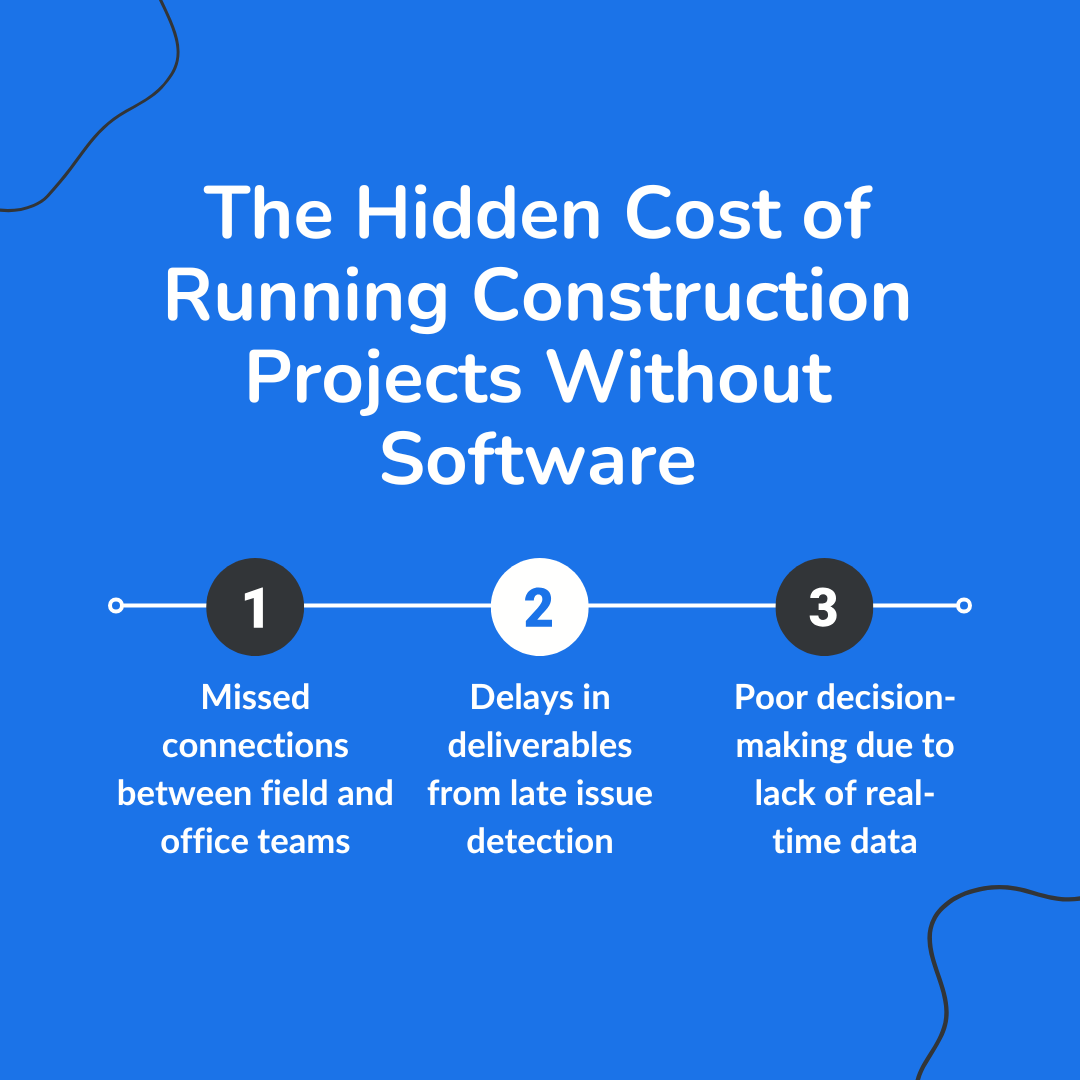
At first glance, running projects with spreadsheets, calls, and paper files seems cheaper than investing in new tools, but the hidden costs tell a different story.
When information is scattered and updates are difficult to track, small issues can grow into larger problems that eat into profits and slow down progress.
1. Missed Connections Between Teams
When updates live in different channels, critical details slip through the cracks. Field crews and office staff often work with conflicting information, and small gaps in communication can slow progress across the entire project.
2. Delays in Deliverables
Manual tracking makes it more difficult to identify issues early. By the time an error surfaces, it’s usually too late to correct without delay. This adds days or weeks to schedules and makes it harder to deliver projects as promised consistently.
3. Weak Decision Making
Without real-time data, leaders are forced to rely on guesswork. Budget adjustments, resource planning, and change orders all happen more slowly because there’s no reliable view of project status. That delay in decision-making not only eats into profit but also damages trust with clients.
Check out: 5 Strategies to Prevent Construction Project Delays
Defining ROI in Construction Project Management
Owners often hear the term “ROI” thrown around, but rarely see what it means in real terms for construction projects.
In this context, return on investment is about saving time, reducing risk, and improving predictability across the project. Here’s how that plays out:
- More Than Cost Savings: ROI includes time saved from faster approvals, fewer delays, and smoother handoffs. That time directly translates into lower overhead and faster payments.
- Better Risk Control: When documents, budgets, and tasks live in one system, mistakes are caught earlier. This reduces the chance of rework or disputes that drain profit.
- Stronger Insights for Planning: ROI also shows up in visibility. A clear view of project progress and costs makes forecasting more reliable, helping leaders plan ahead with confidence.
Faster Closeouts & Better Cash Flow with Construction Management Software
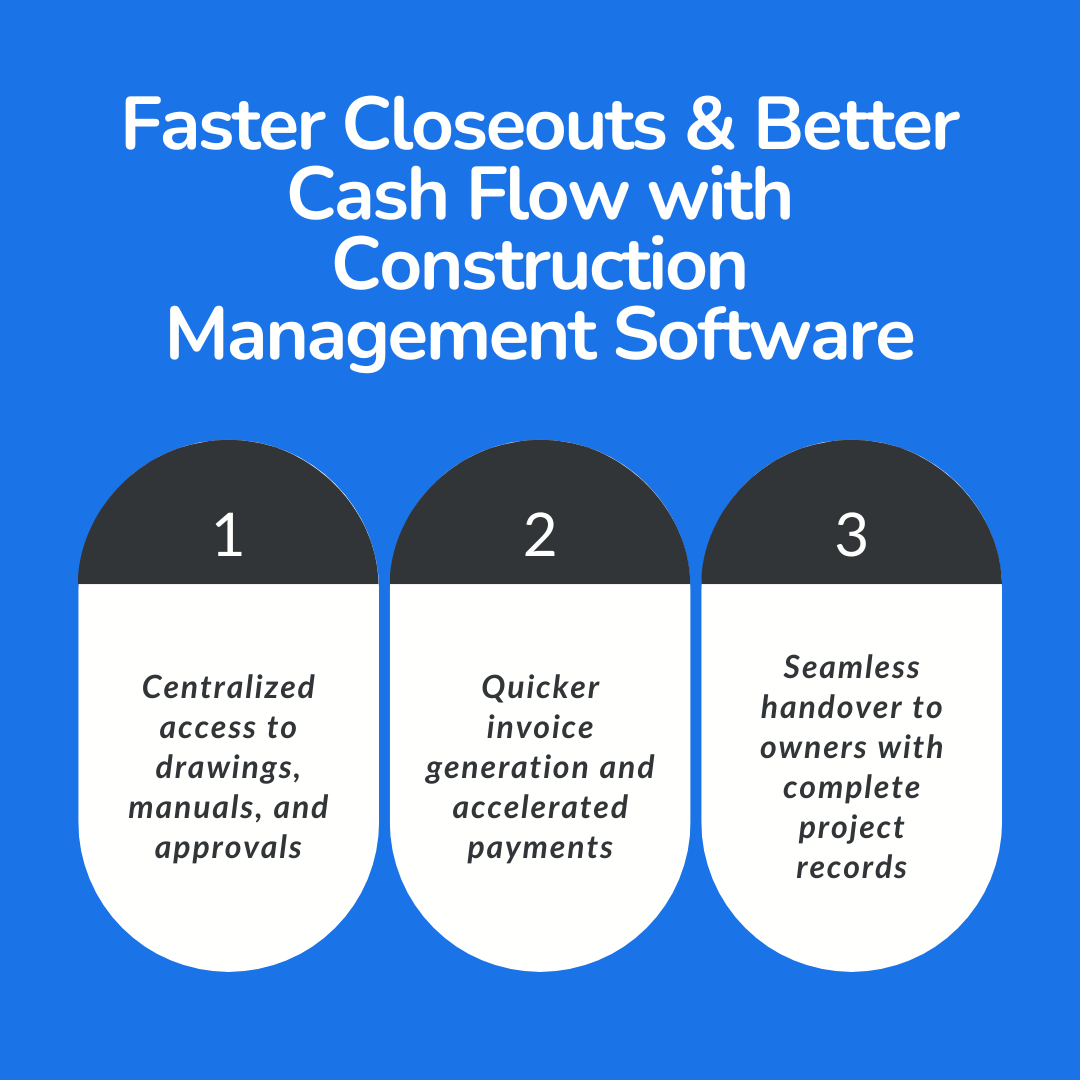
Closeouts are often the most stressful stage of a project. Teams juggle punch lists, final inspections, warranties, and billing, all while trying to wrap up fieldwork.
Without the right tools, this phase drags on for weeks and locks up cash flow. Modern construction management software changes that picture by making the process smoother and more predictable.
- Everything in One Place: A cloud-based solution keeps drawings, manuals, and approvals accessible to both office and field staff. No more chasing paper binders or waiting for someone to email the latest file. Updates are visible instantly, which speeds up the closeout process.
- Smoother Payments: Faster closeouts mean invoices go out sooner and payments arrive earlier. This improves cash flow and reduces the financial strain of waiting for final checks to clear.
- Seamless Handover: When all project information is stored and tracked in one system, the turnover to owners is straightforward. Owners get confidence, and contractors get paid faster.
Fewer Errors and Disputes Through Document Management
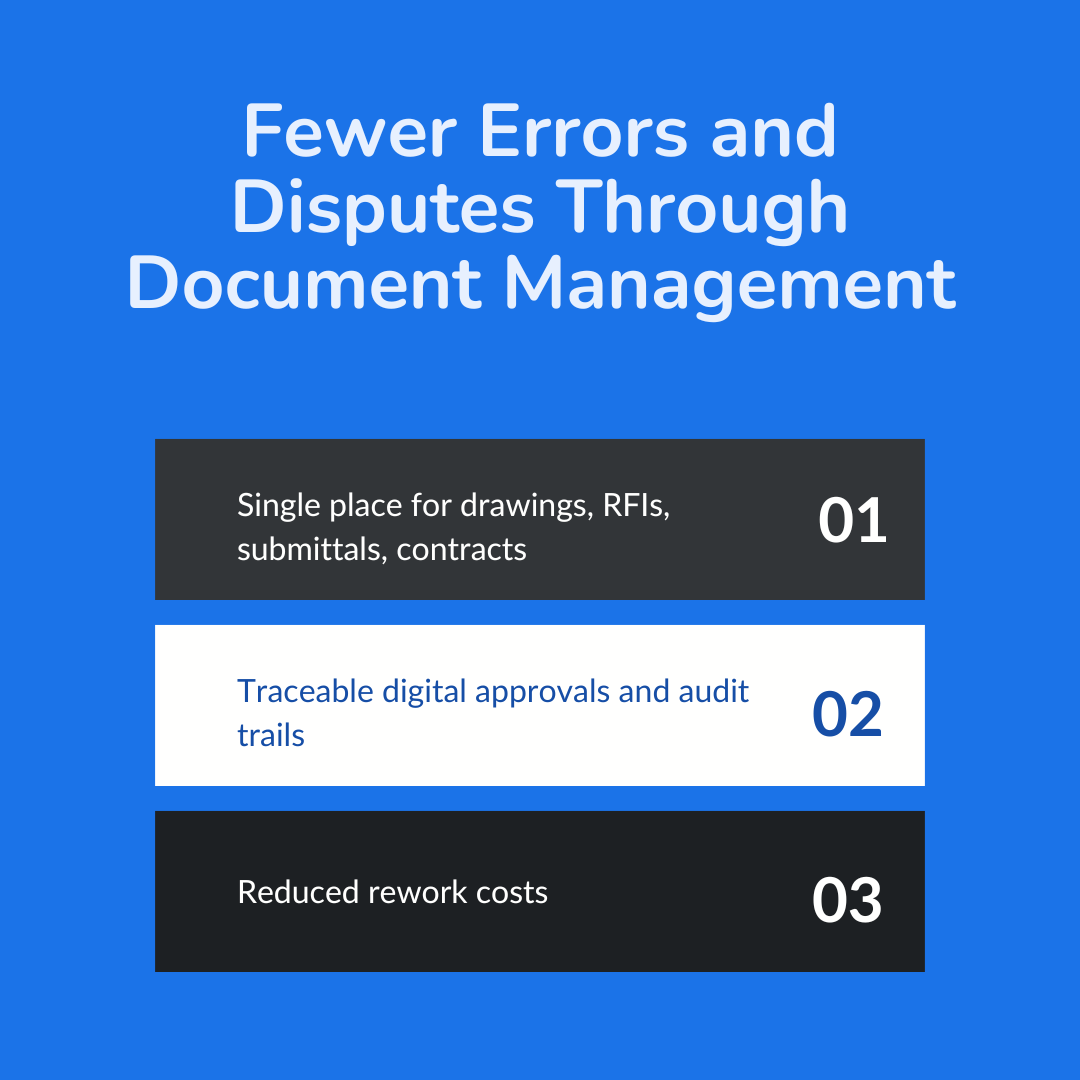
Mistakes in construction cause more than frustration. They cost money. A single wrong version of a drawing, a missing approval, or an overlooked change order can lead to rework, extra labor, and tense conversations with clients. These errors also open the door to disputes that drag out projects and damage relationships.
- Centralized Records: With document management built into modern construction software, every file, drawing, RFIs, submittals, and contracts live in one organized system. Everyone works from the same information, reducing the chance of mismatched versions.
- Traceable Approvals: Digital workflows create a clear record of who signed off on what, and when. This audit trail prevents finger-pointing and helps resolve conflicts quickly.
- Lower Rework Costs: By catching inconsistencies early, teams avoid tearing out and redoing work. Less rework means projects stay on track and profit margins are protected.
Forecasting and Budget Control with One Platform
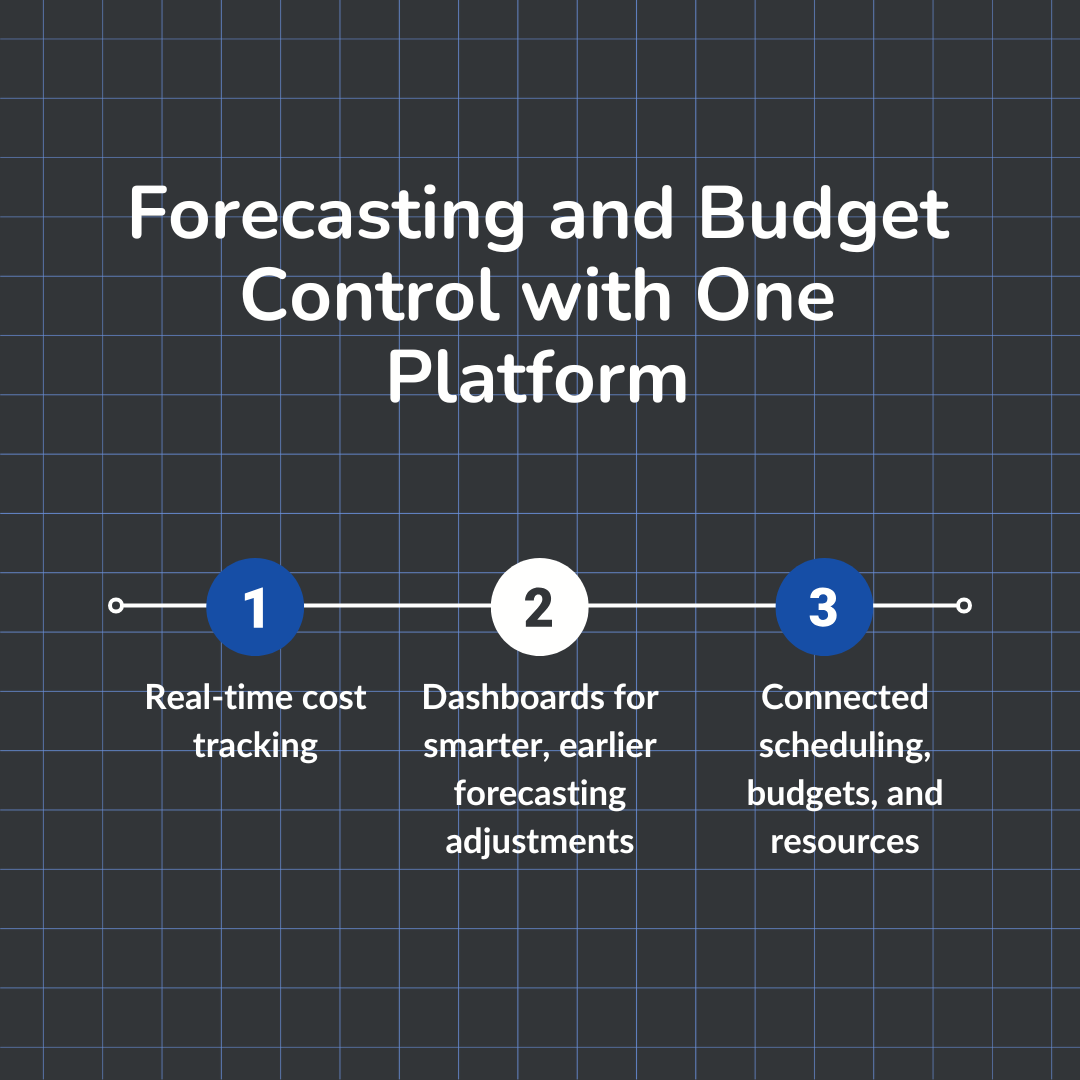
Keeping a project profitable depends on knowing where money is going and what’s coming next. When budgets are tracked in spreadsheets or across multiple tools, it’s easy for costs to slip through the cracks.
A connected construction project management system brings everything together, giving decision-makers the clarity they need.
- Real-Time Cost Tracking: Instead of waiting weeks for reports, project managers can see up-to-date spending, commitments, and pending change orders. This helps keep budgets aligned with actual progress.
- Smarter Forecasting: Dashboards and reports make future costs clearer, so teams can spot trends and adjust resources before it’s too late. Better forecasting reduces the risk of overspending and helps projects finish within the target.
- Control Across the Entire Project: When scheduling, budgets, and resources are connected in one platform, leaders get a full picture of how decisions affect outcomes. This level of control is what turns unpredictable projects into well-managed ones.
Also read: How Contractors Can Improve Forecasting with Construction Software.
ROI in Practice: General Contractors Who Saw Results
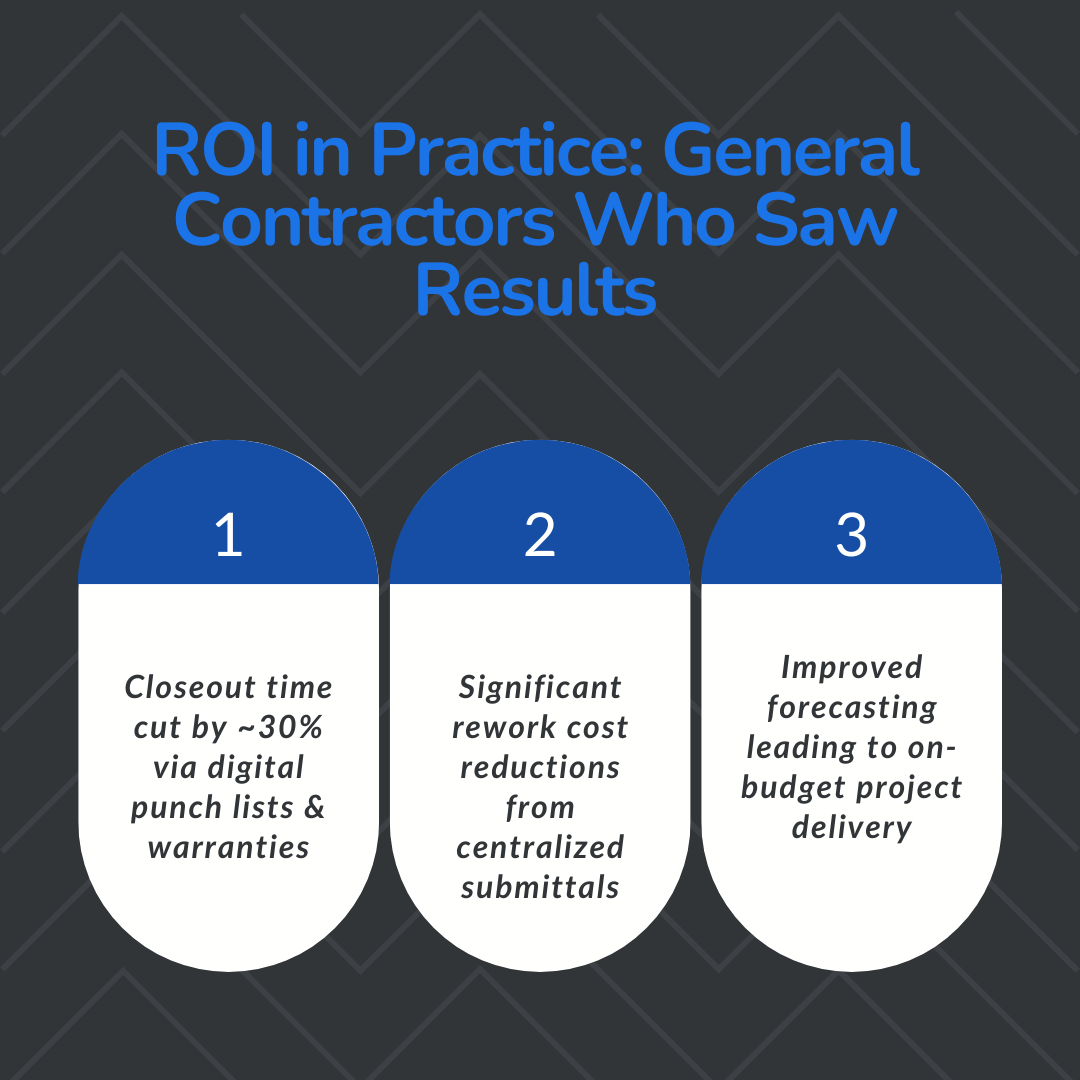
The value of construction management software is clearest when you look at how contractors are using it in the field. These real outcomes show what ROI looks like in practice:
1. Closeout Time Cut by 30%
A mid-sized contractor used digital punch lists and tracked warranties online. What used to take six weeks now takes less than a month, freeing up cash flow sooner.
2. Rework Costs Reduced
Another team centralized submittals and approvals with document management. By catching errors before they reached the site, they lowered rework expenses by thousands of dollars in a single quarter.
3. Forecasting That Stuck
A regional general contractor set up weekly cost reports instead of waiting for end-of-month updates. This let them shift labor early and finish a high-profile project within budget, boosting client trust.
These are the kinds of gains that turn a software license fee into measurable returns.
Overcoming Objections to Construction Management Software
Even when the benefits are clear, owners often hold back because of a few common concerns. Addressing them upfront makes it easier to see where the real value lies.
“It’s too expensive.”
Software costs less than delays, rework, or legal disputes. Many contractors recover the investment within their first few projects through faster payments and fewer mistakes.
“Our team won’t adopt it.”
Modern platforms are designed with simple interfaces and mobile access, so field crews and office staff can use them with little training. Adoption rises when tools fit naturally into daily work.
“We already have tools.”
Managing spreadsheets, email, and separate apps means double entry and missed updates. A unified system connects tasks, budgets, and documents in one workflow, reducing friction instead of adding more.
How ConstructionBase Delivers the Real ROI
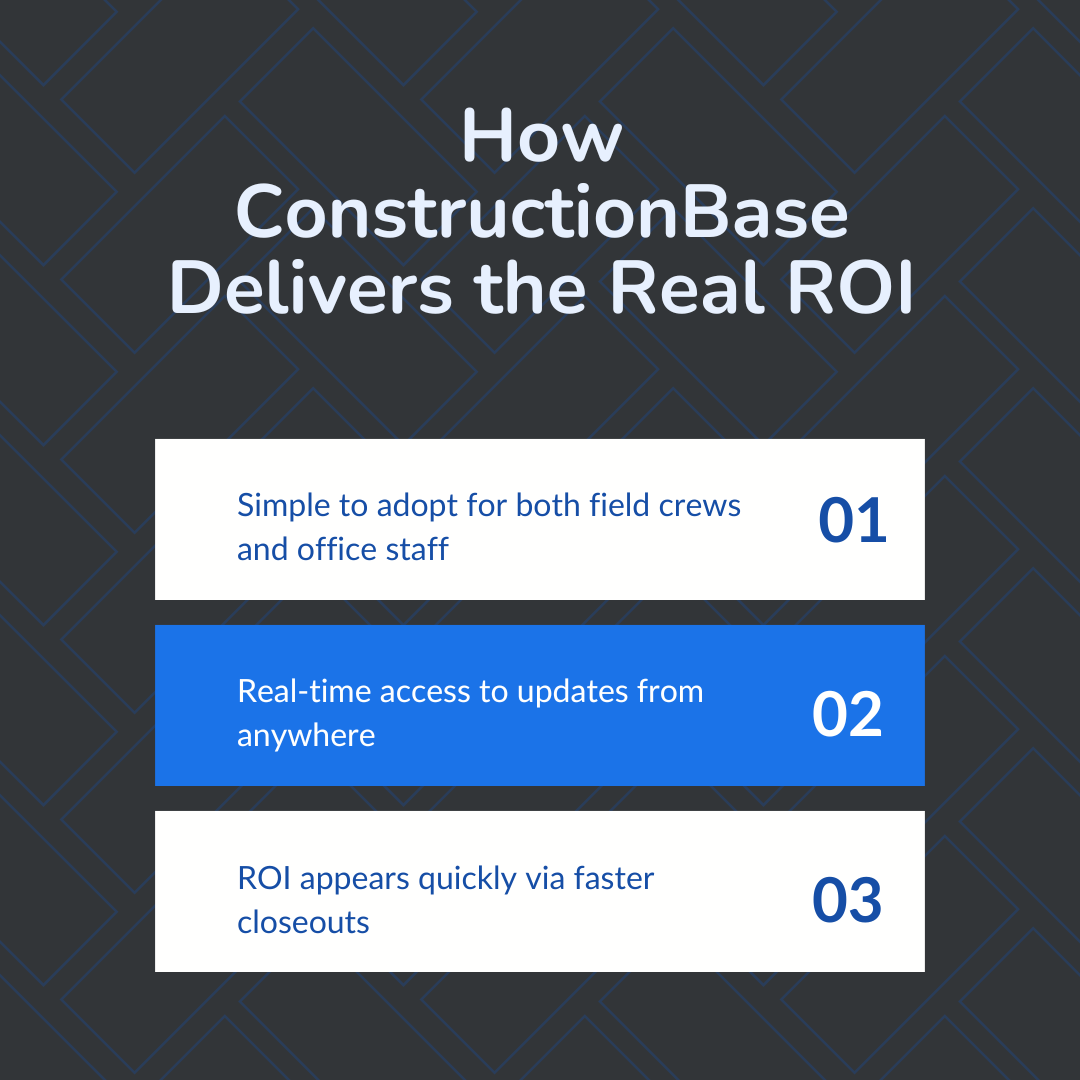
For owners and general contractors who want the benefits of software without the usual headaches, ConstructionBase was built with ROI in mind.
It brings together scheduling, budgets, and document management in one easy-to-use platform so teams spend less time chasing updates and more time moving projects forward.
- Simple to Adopt: ConstructionBase was designed so that crews in the field and staff in the office can use it with minimal training. Adoption happens faster because the tools fit naturally into daily work.
- Risk Management: ConstructionBase helps you spot potential delays, cost overruns, or safety issues before they become bigger problems. Proactive alerts and tracking let you address risks early, reducing costly mistakes.
- Real-Time Access Anywhere: ConstructionBase keeps every update visible in real time. Whether it’s a change order, a budget adjustment, or a checklist, the latest information is always available to the entire project team.
- ROI That Shows Up Quickly: Faster closeouts, fewer disputes, and stronger forecasting mean most firms see returns within their first few projects. What looks like an expense upfront becomes a system that pays back through smoother operations and better margins.
- Reporting & Analytics: It helps you gain insights through customizable dashboards and detailed financial and performance reports to make data-driven decisions.
- Real-Time Communication & Collaboration: Construction projects involve many moving parts. With integrated messaging, notifications, and shared calendars, ConstructionBase keeps teams, subcontractors, and clients aligned.
- Document Management: No more digging through folders or chasing the latest version of plans. All contracts, blueprints, permits, and reports live in one secure, organized place. Everyone works from the same information, reducing errors and misunderstandings.
- Budgeting & Cost Control: Staying on budget is critical for profitability, which is why this platform lets you monitor costs in real time, compare actual spending to your estimates, and forecast where money will be needed next. This kind of visibility helps prevent surprises and keeps projects profitable.
- Scheduling & Task Management: Planning and adjusting timelines doesn’t have to be complicated. With ConstructionBase, you can map out your entire project schedule, assign tasks, and move things around as priorities change. Everyone knows what’s next, deadlines are clear, and nothing slips through the cracks.
With ConstructionBase, the hesitation around software turns into confidence that the investment will pay off.
Also read: How to Choose the Right Construction Proposal Software
Conclusion: The Real ROI of Construction Project Management Software
The hesitation around software often comes down to cost, but the real expense is in delays, rework, and lost opportunities.
With the right platform, construction projects run smoother, closeouts finish faster, and decision-making gets sharper. The return isn’t theoretical; it shows up in cash flow, margins, and client trust.
Ready to see the difference?
ConstructionBase brings scheduling, budgeting, and document management into one platform that delivers measurable results.
Cut delays, reduce risk, and keep every project on track. Book a demo today and start turning unpredictability into ROI.
FAQs
1. Is construction project management software only for large companies?
No. Contractors of all sizes can benefit. Smaller firms often see ROI even faster because they replace manual processes with a single system that saves time and reduces errors.
2. How quickly can contractors expect a return on investment?
Many general contractors recover the cost within their first few projects, thanks to faster closeouts, fewer disputes, and improved forecasting.
3. What makes ConstructionBase different from other platforms?
ConstructionBase combines estimating, scheduling, tracking, and document management in one place. It’s built for easy adoption, so teams can use it right away without slowing down daily work.
Have questions or need personalized advice?
Talk to an Expert Today and let our construction specialists guide you to success.







